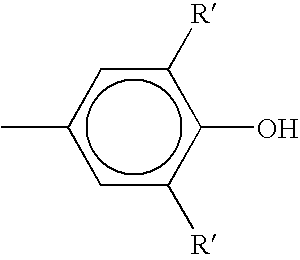Flame retardant crosslinkable compositions and articles
a crosslinkable composition and polyolefin technology, applied in the field of flame retardant, crosslinkable polyolefinbased compositions and articles, can solve the problems of deficient flame retardance of membranes produced in accordance with the above-referenced disclosures, and limit their utility to lower temperature membrane applications
- Summary
- Abstract
- Description
- Claims
- Application Information
AI Technical Summary
Benefits of technology
Problems solved by technology
Method used
Image
Examples
examples 1 and 2
[0065] Two compositions were prepared by melt blending the silane copolymer with MB1 and MB4 in ratios so that the products had the following compositions.
Product Ex. 1Product Ex. 2Ethylene-VTMOS Copolymer (wt. %)47.545Plastomer (wt. %)16.316.3ATH (wt. %)32.732.7DBTDL (wt. %)0.0350.070Additional Additives (wt. %)1.01.0LDPE (wt. %)2.4654.93
[0066] Both compositions exhibited good processing characteristics and the resulting extrudates had smooth surfaces, i.e., no procure in the extruder. A high degree of cure was achieved after allowing the sample to stand overnight in a 90° C. water bath as evidenced by the gel contents of 64% (Ex. 1) and 66% (Ex. 2). Tensile strength and elongation at break for the cured sample of Ex. 1 were 2271 psi and 413%, respectively, while tensile strength and elongation at break for the cured sample of Ex. 2 were 2218 psi and 293%, respectively. Heat aging of the cured samples in an oven for 7 days at 121° C. resulted in a tensile strength and elongation ...
example 3
[0067] A flame retardant crosslinkable composition comprised of 50 wt. % silane copolymer, 16.3 wt. % plastomer, 32.7 wt. % hydrated inorganic filler and 1.0 wt. % stabilizer was prepared by melt blending the ethylene-VTMOS copolymer and MB2. The effect of storage conditions on membrane weldability was simulated by heat aging the 15 mil tape in an oven at 120° F. for 15 days. T-peel results after heat aging were 13.8 lb / in compared to 12.7 lb / in for the unaged sample, indicating that storage conditions would not have a detrimental effect on membrane weldability.
example 4
[0068] For this example 45 wt. % ethylene-VTMOS copolymer was melt blended with 50 wt. % MB2 and 5 wt. % MB4. Extrudate surface appearance was good. The product exhibited good curability as evidenced by the 65% gel content obtained after allowing the sample to cure overnight in a 90° C. water bath. Tensile strength and elongation at break for the cured sample were 2045 psi and 394%, respectively. Heat aging the cured sample for 7 days at 121° C. resulted in a tensile strength and elongation break of 2308 psi and 254%, respectively. These results confirm the long term heat stability of the blend. Burn rate of the composition was 12.8 mm / min as determined by UL 94 horizontal burn test. This is an established procedure within the industry to simulate field flameability performance. A burn rate of less than 20 mm / min is considered to be acceptable performance in this test.
PUM
| Property | Measurement | Unit |
|---|---|---|
| density | aaaaa | aaaaa |
| weight percent | aaaaa | aaaaa |
| melt index | aaaaa | aaaaa |
Abstract
Description
Claims
Application Information
 Login to View More
Login to View More - R&D
- Intellectual Property
- Life Sciences
- Materials
- Tech Scout
- Unparalleled Data Quality
- Higher Quality Content
- 60% Fewer Hallucinations
Browse by: Latest US Patents, China's latest patents, Technical Efficacy Thesaurus, Application Domain, Technology Topic, Popular Technical Reports.
© 2025 PatSnap. All rights reserved.Legal|Privacy policy|Modern Slavery Act Transparency Statement|Sitemap|About US| Contact US: help@patsnap.com



